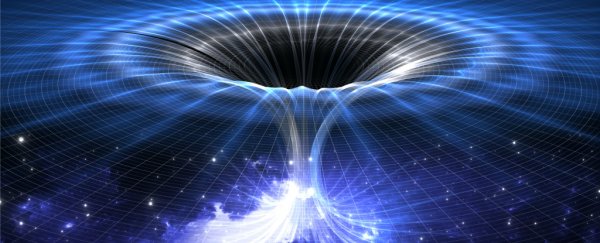Theoretical physicists have put forward a new hypothesis that aims to connect the world of visible physics to the hidden forces of our Universe: what if there's a portal that bridges the gap between the standard model to dark matter and dark energy?
The idea is that the reason we struggle to understand things such as dark matter and dark energy isn't because they don't exist - it's because we've been oblivious to a portal through which regular particles and these 'dark particles' interact. And it's something that could be tested experimentally.
The idea of portals in the Universe might sound pretty crazy, but let's be clear for a second: we're talking portals on the quantum, teeny-tiny scale here - nothing that you could drive a spacecraft through.
And it's not the first time these kinds of portals have been explored in the world of theoretical physicists.
The concept exists because there's a big gap in physics between what can be referred to as 'visible physics' - stuff we can measure and directly detect, such as electromagnetism and photons - and 'dark physics', which is made up of things we can feel the effects of but can't actually interact with, such as dark matter and dark energy.
Portals are our attempt to explain how these two seemingly separate worlds interact to form the Universe we live in.
The visible side of physics hinges on 17 catalogued types of particles that make up the standard model - including electrons, photons, and the Higgs boson.
But unfortunately, the standard model can't explain everything we see happening in the Universe. Crucially, it can't explain gravity or the rate of expansion of the Universe.
 Institute for Basic Science
Institute for Basic Science
This has led to the proposal of the hypothetical forces of dark matter and dark energy - which are predicted to make up 95 percent of the Universe. There's just one problem - no one has ever been able to see or detect either of these forces.
It's been suggested that there might be hidden, dark particles that make up dark matter and dark energy that our tools are incapable of detecting, and it's something that experiments such as the Large Hadron Collider are working on, by smashing together regular particles in the hopes of finding something from this dark sector of physics in the wreckage.
But so far, the world of dark physics has eluded us. And that leaves a big gap that researchers are eager to fill in in order to complete our understanding of the Universe.
Now, a potential solution has been put forward. According to a new study by researchers from the Institute of Basic Science in South Korea, the gap could be bridged by a new type of portal, known as a 'dark axion portal'.
Portals between the dark and visible worlds of physics are already something that theoretical physicists are investigating, but until now, there have only been two types of portals put forward: vector portals and axion portals.
These portals are based on two hypothetical dark sector particles that researchers predict might exist - the axion and the dark photon.
An axion is thought to be a very light particle that has been proposed to solve some of the theoretical problems with the standard model. The dark photon is like a dark version of photons - particles of visible light.
But instead of interacting with electromagnetic charge like regular photons, dark photons would also couple to the so-called dark charge, which might be carried by other dark sector particles.
In the past, axion and vector portals have been used experimentally to try to find evidence of these two particles, but the team suggests that their dark axion portal could be the missing piece of the puzzle.
The basic idea behind the new portal is that a type of heavy quark might exist in the standard model that also carries a dark charge - which would mean they could couple to dark photons.
Through this heavy quark, axions, photons, and dark photons can all interact, the team suggests - as you can see illustrated below:
 Institute for Basic Science
Institute for Basic Science
"The dark axion portal suggests the first meaningful connection between the two physics, which have been studied separately: it connects the dots," said lead researcher LEE Hye-Sung.
"This will allow reinterpretation of the previous data, and potentially make a breakthrough in the axion and dark photon searches."
The team has so far simply put forward the idea of the portal and outlined how it might work, but they're now proposing new experiments that could actually use the portal to test whether axions and dark photons actually exist once and for all.
It's a pretty bold idea, and we won't have an indication of how sound it is until it's tested further.
But until we can find a way to detect the dark sector of physics, we're only seeing half the picture of the Universe - so scientists need to keep throwing these ideas out there until something sticks.
We're looking forward to seeing where they go with the idea next.
The research has been published in Physical Review Letters.
